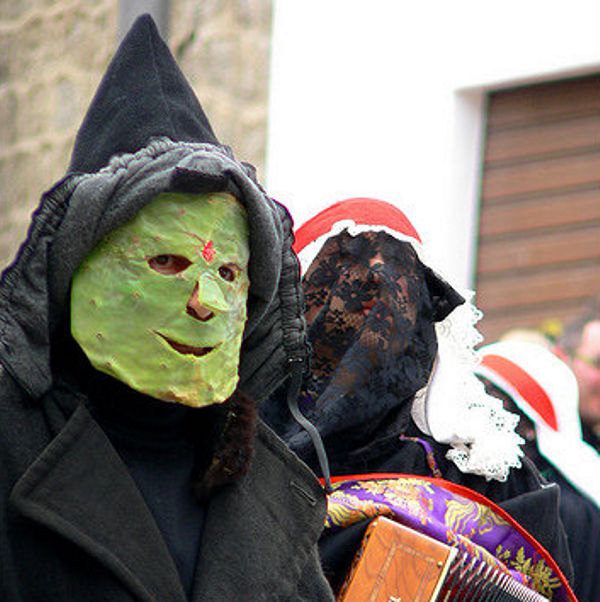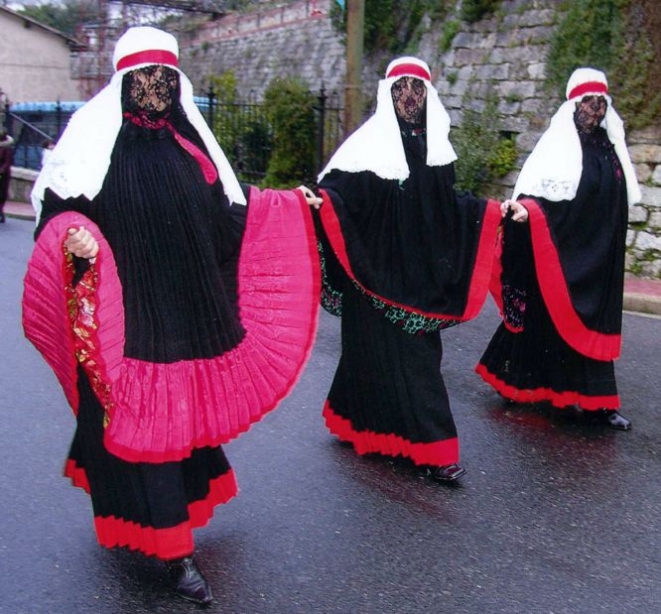The Carnival of Sarule: the Maschera a Gattu and Su Maimone
Symbolism and magic behind a mask
January is certainly the start point of the period of Carnival; it is the exact moment that indicates this beginning. In Sardinia, a territory of folklore and traditions, the various villages and the various towns offer an open air museum of costumes typical of this celebration. Each of these guarantees color and fantasy in the representation of the clothes typical of own area, but some represent the top of distinctive trait and uniqueness.
Among these excels Sarule, a village in the province of Nuoro, whose characterizing feminine costume, the Maschera a Gattu, is really unique, because it has, as a main symbol, elegance, that is present above all on the mask worn on the head. Indeed, it is composed of a black lace veil put on the face, of a white canvas light blanket on the head and of a red band, that blocks the overhead light blanket.

The choice of these colors and of these clothes is given by the reason according to which each represents an important event in a person’s life: the black veil indicates death; instead, the white light blanket represents birth; and the red band indicates the perfect union between two individuals, namely wedding.
In the underlying section, women wear duos oddes, namely, two woolen skirts on the reverse side, put in this way for remembering an abstract idea, namely that of anonymity, and a more concrete and pragmatic idea, namely hiding embroideries. One skirt is tied on the neck and the other on the waist.
Sometimes, the choice is linked to the use of an only skirt, anyway worn on the reverse side, that is put on the neck and is worn above the trousers called "a s'isporta" with "sos cambales".
Already since 1850, in the village of Sarule, citizens used to resort this mask, so called for the posture and the way of move themselves.
The artisans who create this kind of dress, a symbol of the tradition of Carnival, are able professionals; perfectionists in the realization of the original style of the traditional costume.
The most long times are dedicated to skirts, trying and succeeding still in an impeccable way to respect and to follow the ancient techniques. Each element of clothes is rigorously made by hand.

The equivalent masculine suit is called Su Maimone and it is characterized by a mask put on the face, made with pane de morisca, namely, the dried leaf of prickly pears.
The other important clothes are: su gappottinu – a woolen coat - sos pantalones a s'isporta – velvet riding trousers - sos cosinzos – boots - e sos cambales – leather legs.
This costume represents a puppet, that is a source of good auspice.
According to the ancient tradition, citizens showed the crowd a puppet, that was adorned with the same clothes that compose the mask of Su Maimone and that was transported on a float, around the village. It was useful for farmers and shepherds to wish them a great job and a likewise great production.
This mask, too, needs very long times for its realization, above all for creating sos cambales, for which it is necessary to have the perfect shins shape.
So, it is important a bigger period of manufacturing. Su gappottinu, sos cosinzos and su pantalones a s’isporta are worked in about some months. But the most hard work is completely dedicated to the mask, that needs some years because of the long drying of the prickly pear slab.
Static nature is not conceived for who wears these costumes typical of the Carnival of Sarule. Indeed, celebration is given above all by the movement of these ornamentations and decorations that fall perfectly on the dancers’ body. Indeed, Sa Bicchirina, su Passu Seriu and su Passu Torrau represent some examples of traditional dances of the village, that show activities of daily life. They are performed also during the masks parade and have, as an accompaniment, the music offered by the accordion or by the Song by Tenor - Su Concordu.
It is important to mention the Group of Dance that was established by the Company of Sarule, the Association Maschera a Gattu and Maimone, applied itself actively in the most important parades and festivals of the Island, such as the Festival of Saint Efisio in Cagliari, of the Redeemer in Nuoro and the Sardinian Horse Riding in Sassari.